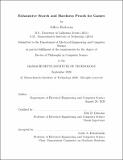| dc.contributor.advisor | Erik D. Demaine. | en_US |
| dc.contributor.author | Bosboom, Jeffrey(Jeffrey William) | en_US |
| dc.contributor.other | Massachusetts Institute of Technology. Department of Electrical Engineering and Computer Science. | en_US |
| dc.date.accessioned | 2021-01-06T19:35:07Z | |
| dc.date.available | 2021-01-06T19:35:07Z | |
| dc.date.copyright | 2020 | en_US |
| dc.date.issued | 2020 | en_US |
| dc.identifier.uri | https://hdl.handle.net/1721.1/129245 | |
| dc.description | Thesis: Ph. D., Massachusetts Institute of Technology, Department of Electrical Engineering and Computer Science, September, 2020 | en_US |
| dc.description | Cataloged from student-submitted PDF of thesis. | en_US |
| dc.description | Includes bibliographical references (pages 275-289). | en_US |
| dc.description.abstract | This thesis explores several games from two perspectives: exhaustive search and hardness proofs. First, we present an exhaustive search for hardness proofs: a system for finding motion planning simulations. Second, we prove that the pencil-and-paper puzzle Tatamibari is NP-complete, a proof developed using a Tatamibari solver we wrote based on the Z3 SMT solver. Third, we find by computer search that the board game Push Fight played on a board with one column (four squares) removed is a draw. Then we prove that mate-in-1 in generalized Push Fight is NP-complete and that determining the winner of a game in progress is PSPACE-hard. Fourth, we prove that path puzzles are NP-complete, ASP-complete, and #P-complete. We describe a solver for path puzzles based on depth-first search that solves 14 of 15 puzzles from the last chapter of the path puzzles book. Fifth, we present a nonogram solver based on automaton intersection. Relatedly, we prove that finding an optimal automaton intersection ordering is PSPACE-hard. Sixth, we analyze puzzles from the video game The Witness and obtain NP-completeness for most clue types and [sigma]₂-completeness for puzzles containing antibody clues. Finally, we propose a generic framework for parsing screenshots of grid-based video games. | en_US |
| dc.description.statementofresponsibility | by Jeffrey Bosboom. | en_US |
| dc.format.extent | 289 pages | en_US |
| dc.language.iso | eng | en_US |
| dc.publisher | Massachusetts Institute of Technology | en_US |
| dc.rights | MIT theses may be protected by copyright. Please reuse MIT thesis content according to the MIT Libraries Permissions Policy, which is available through the URL provided. | en_US |
| dc.rights.uri | http://dspace.mit.edu/handle/1721.1/7582 | en_US |
| dc.subject | Electrical Engineering and Computer Science. | en_US |
| dc.title | Exhaustive search and hardness proofs for games | en_US |
| dc.type | Thesis | en_US |
| dc.description.degree | Ph. D. | en_US |
| dc.contributor.department | Massachusetts Institute of Technology. Department of Electrical Engineering and Computer Science | en_US |
| dc.identifier.oclc | 1227516732 | en_US |
| dc.description.collection | Ph.D. Massachusetts Institute of Technology, Department of Electrical Engineering and Computer Science | en_US |
| dspace.imported | 2021-01-06T19:35:06Z | en_US |
| mit.thesis.degree | Doctoral | en_US |
| mit.thesis.department | EECS | en_US |
